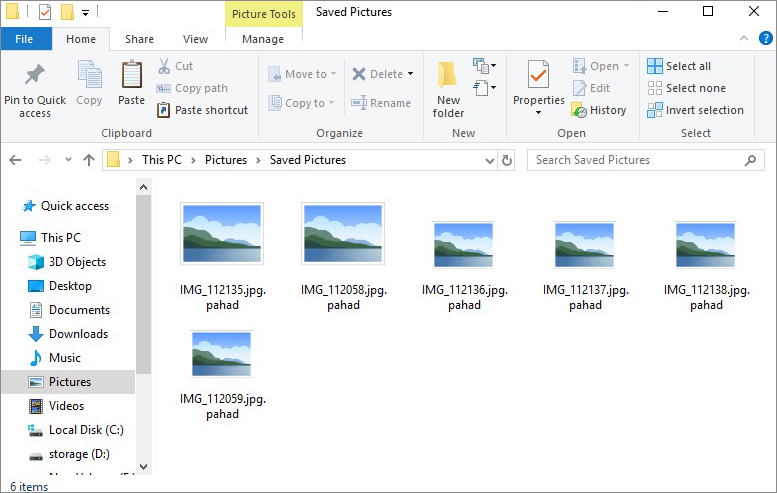Please, have in mind that SpyHunter offers a free 7-day Trial version with full functionality. Credit card is required, no charge upfront.
How to Remove .Pahad File Extension Ransomware?
Pahad File Virus is a ransomware threat from the STOP/DJVU family. The infection is malicious and dangerous, and the people who unleashed it on you are untrustworthy. The Pahad ransomware infiltrates your system undetected, then proceeds to use AES encryption to lock the data you keep on your PC. Images, videos, music, documents, everything gets encrypted. The cyberthreat adds the “.pahad” extension to it, solidifying its grip and making your files inaccessible. Once it finishes the encryption, it leaves you a “_readme.txt” file. It clues you into your predicament and contains instructions to follow. Do NOT follow them! Doing anything the cybercrooks behind Pahad want from you will only lead to further trouble.
The ransom text reads as follows:
ATTENTION!
Don’t worry, you can return all your files!
All your files like photos, databases, documents and other important are encrypted with strongest encryption and unique key.
The only method of recovering files is to purchase decrypt tool and unique key for you.
This software will decrypt all your encrypted files.
What guarantees you have?
You can send one of your encrypted file from your PC and we decrypt it for free.
But we can decrypt only 1 file for free. File must not contain valuable information.
You can get and look video overview decrypt tool:
https://we.tl/t-WJa63R98Ku
Price of private key and decrypt software is $980.
Discount 50% available if you contact us first 72 hours, that’s price for you is $490.
Please note that you’ll never restore your data without payment.
Check your e-mail “Spam” or “Junk” folder if you don’t get answer more than 6 hours.
To get this software you need write on our e-mail:
helpteam@mail.ch
Reserve e-mail address to contact us:
helpmanager@airmail.cc
Your personal ID:
XXXXXXXXXXXXXXXXXXXXXXXXXXXXXXX
How did I get infected with?
It’s more than likely that you got duped into installing the infection without realizing it. Since threats like Pahad require permission to enter your system, they turn to every trick in the book to get it. They hide behind fake updates, corrupted links and sites, and, of course, freeware. That’s why it’s essential always to be vigilant when online. Be careful what you click and what you agree to allow into your system. Even a little extra attention can save you a ton of issues.

Why is .Pahad File Extension dangerous?
After the cybercriminals behind Pahad lock your data, they promise to unlock it if you pay them. Supposedly, if you do that, they’ll send you a decryption key that will free your files. However, ask yourself whether you can trust these people? The answer is no. What if you pay, but they don’t send you the promised key? Or give you one that fails to work? And, even if you get the right one, what if as soon as you use it and decrypt your data, they proceed to lock it again? Don’t waste your money, time, and energy dealing with these people. Cut your losses, and create backups, so you don’t face this choice again in the future.
.Pahad File Extension Removal Instructions
Please, have in mind that SpyHunter offers a free 7-day Trial version with full functionality. Credit card is required, no charge upfront.
STEP 1: Kill the Malicious Process
STEP 3: Locate Startup Location
STEP 4: Recover .Pahad File Extension Encrypted Files
STEP 1: Stop the malicious process using Windows Task Manager
- Open your task Manager by pressing CTRL+SHIFT+ESC keys simultaneously
- Locate the process of the ransomware. Have in mind that this is usually a random generated file.
- Before you kill the process, type the name on a text document for later reference.

- Locate any suspicious processes associated with .Pahad File Extension encryption Virus.
- Right click on the process
- Open File Location
- End Process
- Delete the directories with the suspicious files.
- Have in mind that the process can be hiding and very difficult to detect
STEP 2: Reveal Hidden Files
- Open any folder
- Click on “Organize” button
- Choose “Folder and Search Options”
- Select the “View” tab
- Select “Show hidden files and folders” option
- Uncheck “Hide protected operating system files”
- Click “Apply” and “OK” button
STEP 3: Locate .Pahad File Extension encryption Virus startup location
- Once the operating system loads press simultaneously the Windows Logo Button and the R key.
- A dialog box should open. Type “Regedit”
- WARNING! be very careful when editing the Microsoft Windows Registry as this may render the system broken.
Depending on your OS (x86 or x64) navigate to:
[HKEY_CURRENT_USER\Software\Microsoft\Windows\CurrentVersion\Run] or
[HKEY_LOCAL_MACHINE\SOFTWARE\Microsoft\Windows\CurrentVersion\Run] or
[HKEY_LOCAL_MACHINE\SOFTWARE\Wow6432Node\Microsoft\Windows\CurrentVersion\Run]
- and delete the display Name: [RANDOM]

- Then open your explorer and navigate to:
Navigate to your %appdata% folder and delete the executable.
You can alternatively use your msconfig windows program to double check the execution point of the virus. Please, have in mind that the names in your machine might be different as they might be generated randomly, that’s why you should run any professional scanner to identify malicious files.
STEP 4: How to recover encrypted files?
- Method 1: The first and best method is to restore your data from a recent backup, in case that you have one.

- Method 2: File Recovery Software – Usually when the ransomware encrypts a file it first makes a copy of it, encrypts the copy, and then deletes the original. Due to this you may try to use file recovery software like Data Recovery Pro to recover some of your original files.
- Method 3: Shadow Volume Copies – As a last resort, you can try to restore your files via Shadow Volume Copies. Open the Shadow Explorer part of the package and choose the Drive you want to recover. Right click on any file you want to restore and click Export on it.


